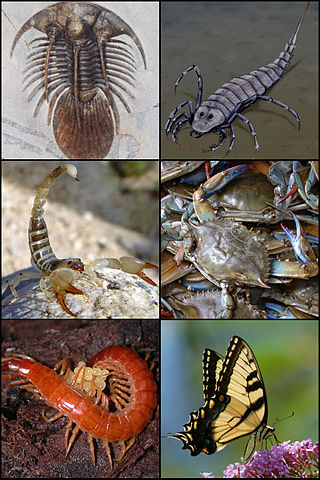
Arthropoda collage. From left to right and from top to bottom: Kolihapeltis (trilobite), Stylonurus (eurypteryid), Scorpion, Crab, Centipede, Butterfly
Wikipedia, Creative Commons Attribution Share Alike
| Arthropoda | ||
| Metazoa | Contents |
| Dinocaridida | Metazoa | Arthropoda | ||
| Ecdysozoa | Arthropoda | Arthropoda | Deuterostomia |
|
Abbreviated Dendrogram
Ecdysozoa
╞═Dinocaridida
│
└─Arthropoda
├─Fuxianhuiida
└─┬─Candaspidida
└─┬─Megacheira
└─┬─Chelicerata
└─┬─Marellomorpha
└─┬─Trilobita
└─Mandibulata
├─Myriapoda
└─┬─Crustacea
└─Hexapoda
|
Contents
Overview |
 Arthropoda collage. From left to right and from top to bottom: Kolihapeltis (trilobite), Stylonurus (eurypteryid), Scorpion, Crab, Centipede, Butterfly Wikipedia, Creative Commons Attribution Share Alike |
One of the most significant inventions of the animal kingdom, the jointed exoskeleton, enabled the arthropods to become the second most abundant form of multicelluar life on Earth (the most abundant being the nematodes). Here we look at the various groups of arthropods, and their evolutionary history and success (or at least we ecventually will, when all the pages have a reasonable amount of content. The most primitive arthropods of all, the Paleozoic Dinocaridida, are equally included under the more inclusive clade Panarthropoda, and so are considered separately. After the dinocaridids, the fuxianhuiids, arre the most primitive arthropods known. The folllowing groups are considered in roughly phylogenetic order, as described in the abbreviated dendrogram above. But as not only the details but even the main lines of arthropod phylogeny remain controversial, our own interpretation here should only be seen as one possible hypothesis among many MAK120520
Most of these pages are still under construction and revision. Note that most of the links here will only work when the other pages are uploaded. MAK120515
Contents
Stem arthropods:
Fuxianhuiida - very primitive or basal early Cambrian arthropods
Candaspidida - very primitive, Cambrian, carapaced arthropods, superficially resembling crustaceans
Megacheira - "great appendage" arthropods with large spiny foreleg in place of antennae, limited to the Cambrian
Chelicerates:
Chelicerata - arthropods with chelicera rather than antennae
Pycnogonida - sea spiders, a poorly known group of basal chelicerates)
Xiphosura - horseshoe crabs and their Paleozoic ancestors
Eurypterida - "sea scorpions", medium-size dto gigantic chelicvcerates, which include the largest arthropods to ver live
Chasmataspidida - early chelicerates related to xiphosurans and eurypterids
Arachnida - spiders, scorpions, and kin
Acari - mites - microscopic arachnids
Araneae - spiders
Stem Mandibulates:
Marellomorpha - very primitive trilobite-like arthropods
Aglaspidida - yet another of those small early paleozoic arthropod groups, until recently thought to be related to chelicerates
Trilobitomorpha - assorted and miscellaneous trilobite-like forms, often included under the paraphyletic taxon "Arcahnomorpha"
Trilobita - the trilobites, armoured forms with three-lobed bodies and primitive limbs, abundant during but limited entirely to the Palaeozoic era
Mandibulata - arthropods with jaws
Myriapods:
Myriapoda - the many legged - millipedes, centipedes, and their relatives
Crustaceans:
Crustaceomorpha - ancestral or proto-crustaceans
Crustacea - the Crustaceans, an extremely important and diverse group
Phosphatocopida - a group of ostracod-like but very primitive Crustacea with phosphatic carapaces
Branchiopoda - fairy shrimps, water fleas and their kin, the most primitive extant crustaceans.
Remipedia - long-bodied many legged types that may (molecular phylogeny) or may not (morphology) be related to insects.
Maxillopoda - a "wastebasket taxon" for Crustaceans that don't fit into the other categories - includes barnacles, copepods, and many more; retained for now pending revision
Ostracoda - "seed shrimps" - tiny bivalved crustaceans with a rich fossil record
Malacostraca - paleozoic carapaced and shrimp-like types, along with extant sand hoppers, pill bugs, krill, and other assorted types
Decapoda - the ten legged: shrimps, lobsters, crabs; the most recognisable and most successful of the crustaceans
Insects:
Hexapoda - six legged arthropods (includes all the following units)
Insecta - the insects, the most important clade of hexapods. This unit introduces the insects and includes primitive wingless forms
Pterygota - winged insects. This unit introduces the Palaeoptera (dragonflies, mayflies, and their Paleozoic relatives)
Palaeodictyopteroida - extremely primitive but succesful Paleozoic beaked insects
Ephemeroptera - the mayflies, one of the four original branches of winged insects
Odonatoptera - dragonflies and their giant paleozoic relatives; darting aerial predators of the insect world
Neoptera - insects that can fold their wings, one of the great evolutionary adaptions of the insect world (includes all the following units)
Polyneoptera - those jumpers and singers the grasshoppers and crickets, the misunderstood earwigs, and the titanic (in insect terms at least) Triassic Titanoptera and extant and equally impressive stick insects
Dictyoptera - the indomitable cockroaches of the Paleozoic undergrowth and their more recent desecndents the crown group cockroaches, termites, and praying mantises
Paraneoptera - lice, thrips, aphids, plant hoppers, cicadas, and true bugs
Holometabola - insects that undergo a larval, pupal, and adult life-cycle - this unit includes a number of minor groups; in addition there are the following four units
Coleoptera - the beetles, who God has an inordinate fondness for (as there are so many different types)
Hymenoptera - ants, bees and wasps, both social insects and solitary types
Diptera - the two wings: flies of all sorts; one of the four largest insect groups
Lepidoptera - moths and butterflies, much beloved of Victorian naturalists, and the second most speciose insectgroup
| Dinocaridida | Metazoa | Arthropoda |
page MAK120515, 120520 Creative Commons Attribution